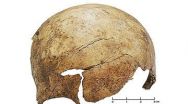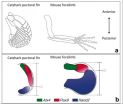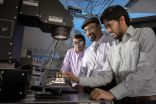(Press-News.org) A new class of fascinating technologies -- including optics in computing, telecommunications links and switches, and virtually any other optical component -- could be created simply by configuring a mesh of light-controlling devices known as interferometers. This is similar to the way electronic semiconductors can fashion the wide array of digital technologies we have at our disposal today.
Optical technologies have the potential to greatly reduce the power consumption of computers, speed telecommunications, and enhance the sensitivity of chemical and biological sensors. The basic building blocks of traditional optics, however, mirrors and lenses, lack the versatility to readily perform these functions and are difficult to scale to the small sizes needed for many applications.
A fundamentally new approach to designing optical technologies -- based on a single device known as a Mach-Zehnder interferometer -- could overcome these limitations and lead to a variety of breakthrough applications, thus, paving the way for an entirely new class of technologies that could give optics the kind of versatility we see in electronics.
"Recently, optical researchers have begun to understand that these interferometers can be thought of as universal 'building blocks' that could enable us to construct essentially any optical device we could imagine," said Dr. David A.B. Miller, Stanford University, California, USA and author of a letter describing the potential of interferometers published today in The Optical Society's new high-impact journal Optica.
Previously, this approach would have only been feasible if the Mach-Zehnder interferometers were able to achieve perfect performance -- a seemingly unattainable goal.
The new approached described in this paper, however, presents an alternate pathway. Rather than engineering a perfect, single component, researchers propose it's possible to create a mesh, or array, of interferometers that, when properly programmed, could compensate for its less-than-perfect parts and deliver overall perfect performance.
"It's this larger scheme that allows us to use reasonable but imperfect versions of these components," explains Miller.
Interferometers Building the Foundation of Technology
Interferometers are basically any device that separate and re-combine light waves. Like sound waves, light waves can be combined so their signals add together. They also can "interfere" and cancel each other out. This basic "on/off" capability is what would allow interferometers to be harnessed and configured in a variety of ways.
Mach-Zehnder interferometers are specialized versions of these devices that split light from one or two sources into two new beams and then recombine them. They are already used for some specific applications in science and for switching beams in optical communications in optical fibers.
Their more general use in consumer and other applications, however, has been obstructed because of the way that the light is initially split as it enters the device. Ideally, the beams would be split in perfect 50/50 symmetry. In reality, however, the split is not nearly so perfect. This means that when the interferometer recombines the signal it cannot be completely canceled, preventing engineers from completely controlling the optical path.
The ability to combine or cancel the signals along a particular path is critical for technology. Researchers realized, however, that if Mach-Zehnder interferometers could be assembled in large meshes and controlled, it would be possible to create a system that achieved the necessary perfect performance. This would allow the meshes to, in principle, perform any so-called "linear" optical operation, much like computers are able to perform any logical application by controlling on/off functions of semiconductors.
Automatic Control Enables Technology
The final element that enabled this process was the invention of algorithms -- essentially the control software -- that allowed the meshes to be "self-configuring," adjusting how they directed the light paths based on the signal received by simple optical sensors embedded in the system.
This self-correcting algorithm allowed the researchers to propose meshes of interferometers with some imperfections and then compensate to make them behave as if they were perfect. The algorithms could then control the "phase shifters" in the interferometers, determining if the signals combined or canceled, by simply monitoring the optical power in various detectors.
"With this development, we are starting to do some things in optics that we have been doing in electronics for some time," observed Miller. "By using small amounts of electronics and novel algorithms, we can greatly expand the kinds of optics and applications by making completely custom optical devices that will actually work."
INFORMATION:
Paper: "Perfect optics with imperfect components," David A.B. Miller, Optica, Vol. 2, Issue 8, pp. 747 (2015). doi: http://dx.doi.org/10.1364/optica.2.000747
About Optica
Optica is an open-access, online-only journal dedicated to the rapid dissemination of high-impact peer-reviewed research across the entire spectrum of optics and photonics. Published monthly by The Optical Society (OSA), Optica provides a forum for pioneering research to be swiftly accessed by the international community, whether that research is theoretical or experimental, fundamental or applied. Optica maintains a distinguished editorial board of more than 20 associate editors from around the world and is overseen by Editor-in-Chief Alex Gaeta, Cornell University, USA.
About The Optical Society
Founded in 1916, The Optical Society (OSA) is the leading professional organization for scientists, engineers, students and entrepreneurs who fuel discoveries, shape real-life applications and accelerate achievements in the science of light. Through world-renowned publications, meetings and membership initiatives, OSA provides quality research, inspired interactions and dedicated resources for its extensive global network of optics and photonics experts. OSA is a founding partner of the National Photonics Initiative and the 2015 International Year of Light. For more information, visit http://www.osa.org.
A national survey of more than 750 emergency medical services providers conducted by researchers at Oregon Health & Science University identified airway management skills, personal anxiety and limited pediatric care proficiency among key factors that may contribute to pediatric safety events for children in out-of-hospital emergent care situations. The study, published online today in The Journal of Pediatrics, supports the American Academy of Pediatrics' recommendation for pediatric physician involvement in EMS training, medical oversight and policy development.
"Pediatric ...
Violent conflicts in Neolithic Europe were held more brutally than has been known so far. This emerges from a recent anthropological analysis of the roughly 7000-year-old mass grave of Schöneck-Kilianstädten by researcher of the Universities of Basel and Mainz. The findings, published in the journal PNAS, show that victims were murdered and deliberately mutilated.
It was during the time when Europeans first began to farm. To what degree conflicts and wars featured in the early Neolithic (5600 to 4900 B.C.), and especially in the so-called Linear Pottery culture ...
A study of catsharks reveals how alterations in the expression and function of certain genes in limb buds underlie the evolution of fish fins to limbs. The findings are reported by researchers from Tokyo Institute of Technology (Tokyo Tech), the Centre for Genomic Regulation (CRG, Barcelona) and their collaborators in the journal eLife and give new insight into how fish evolved to live on land in the form of early tetrapods.
The first four-legged, land-living creatures - known as early tetrapods - evolved from fish, following the transformation of fins into limbs. This ...
Patient satisfaction is a very poor proxy for quality of care comparisons in elective cranial neurosurgery. Because deaths are rare events in elective cranial neurosurgery, reporting of surgeon or even department-specific mortality figures cannot differentiate a high or low level of the quality of care.
The current focus on patient safety in health care has led to public quality-of-care comparisons between health care facilities and even between individual health care professionals. In the United States, a new reimbursement method based on patient satisfaction ratings ...
WEST LAFAYETTE, Ind. - New research findings contradict a fundamental assumption about the functioning of "organic" solar cells made of low-cost plastics, suggesting a new strategy for creating inexpensive solar technology.
Commercialization of organic solar cells has been hindered by inefficiencies, but the findings point toward a potential path to create a new class of solar technology able to compete with standard silicon cells.
"These solar cells could provide a huge cost advantage over silicon," said Muhammad Ashraful Alam, Purdue University's Jai N. Gupta Professor ...
A new international study is the first to use a high-resolution, large-scale computer model to estimate how much ice the West Antarctic Ice Sheet could lose over the next couple of centuries, and how much that could add to sea-level rise. The results paint a clearer picture of West Antarctica's future than was previously possible. The study is published today (18 August) in The Cryosphere, an open access journal of the European Geosciences Union (EGU).
"The IPCC's [Intergovernmental Panel on Climate Change] 4th and 5th Assessment Reports both note that the acceleration ...
A group of clinicians and geochemists are working to develop a test for the most common form of primary liver cancer, HCC (Hepatocellular Carcinoma). HCC kills over 600,000 people worldwide every year. It usually develops from chronic liver disease such as hepatitis or cirrhosis, but there is no good biochemical test to indicate when the cancer develops, meaning that even for patients most at risk, it is nearly impossible to know when a cancer may develop until symptoms appear. Now a multi-national group of scientists are developing a new test for HCC, based on methods ...
COLUMBUS, Ohio - Employees with a racially diverse group of friends outside of work may actually perform better at their jobs, a new study suggests.
Researchers found that workers who had more different-race friends in their personal lives than their co-workers also tended to have a more racially diverse network of friends on the job. This broader network was linked to employees who did more tasks beyond their job responsibilities and who, under certain circumstances, had more trust in their supervisors.
"Your friends outside of work actually have this connection to ...
This news release is available in French. This news release is available in French. New research shows that teaching young adolescents practical cooking skills leads to positive changes for the entire family. In an article published today in Applied Physiology, Nutrition, and Metabolism, an NRC Research Press journal (a division of Canadian Science Publishing), researchers evaluated the Kinect-Ed presentation and found an increase in the frequency of family dinners after participation.
Kinect-Ed, a 90-minute motivational nutrition education presentation, was ...
BOSTON, Aug. 18, 2015 -- Cranberries are often touted as a way to protect against urinary tract infections, but that may be just the beginning. Researchers fed cranberry extracts to mice with colon cancer and found that the tumors diminished in size and number. Identifying the therapeutic molecules in the tart fruit could lead to a better understanding of its anti-cancer potential, they say.
The team will describe their approach in one of more than 9,000 presentations at the 250th National Meeting & Exposition of the American Chemical Society (ACS), the world's largest ...



